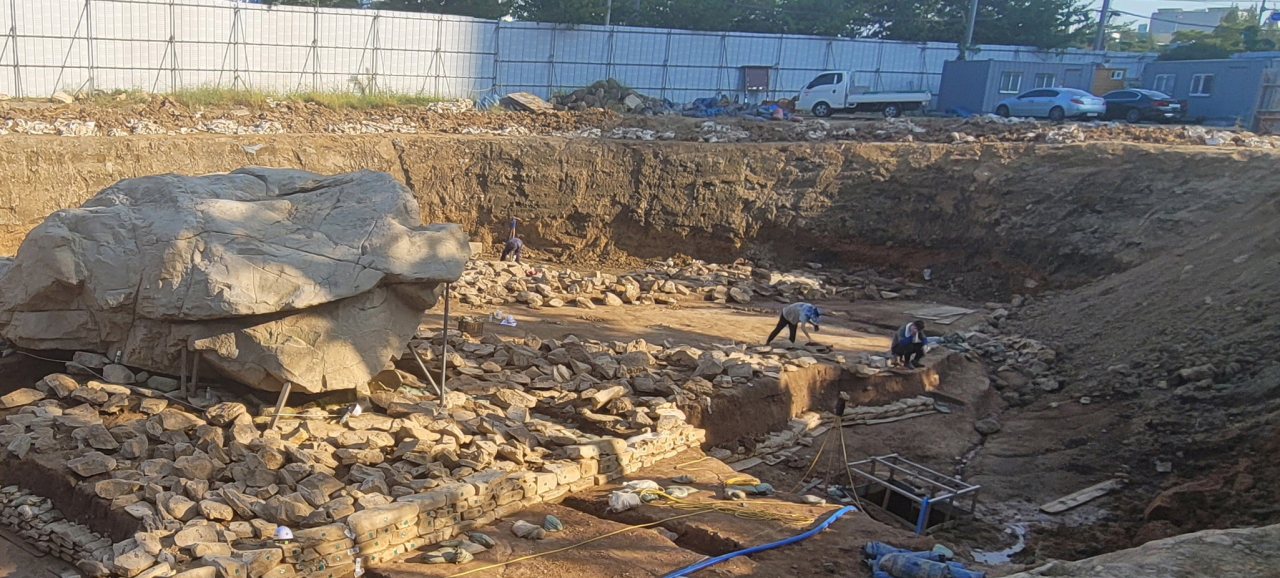
Gusan-dong Dolmen located in Gusan-dong, Gimhae, South Gyeongsang Province, is seen on Saturday. (Yonhap)
A 350-metric-ton Bronze Age dolmen in Gimhae, South Gyeongsang Province -- one of the largest dolmens in the world -- was discovered to have been damaged during a recent restoration process.
The damage was reported to the Cultural Heritage Administration by Cultural Heritage Committee members who visited the site on July 28 to conduct preliminary research for the dolmen’s designation as a national historical site. The CHA halted all restoration work on Aug. 1. The city of Gimhae initiated a multiphased restoration project of the dolmen site in December 2020.
It was not immediately clear how the dolmen was damaged or the extent of the damage.
“We are now finding out the exact condition and the extent of the damage,” an official at the CHA who visited the site Friday told The Korea Herald.
The restoration work, which took place between May and June, involved removing the upper capstone that served as a roof and the lower layer stones which served as the foundation for erecting the dolmen.
The dolmen located in Gusan-dong, Gimhae, was discovered in 2006 during a housing development project in the area. The dolmen measures 10 meters in length, 4.5 meters in width and 3.5 meters in height with its boundary occupying some 1,652 square meters.
At the time of the discovery, Gimhae preserved the artifact by filling the area around the dolmen with soil as a temporary measure. A lack of budget was cited as the main reason for the temporary measure.
On Saturday, Gimhae admitted to its faults and said it would follow the CHA’s decisions moving forward.
The city, however, insisted that no heavy equipment was used in the removal of the stones. The stones that had been affected by natural conditions were taken out by hand and treated to be strengthened before being replaced in their original locations, it said.
“The first principle of historical site preservation is ‘maintaining its original form,’” Lee Cheong-gyu, a professor of cultural anthropology at Yeongnam University and a Cultural Heritage Committee member, told The Korea Herald Sunday. “Aside from examining what was done to the stones for preservation, the act of removing the stones in itself is damage done to the site.”
Lee added that when the committee members visited the site, they witnessed a civil engineering company conducting the restoration work.
“Stone relics require a very specific type of knowledge and expertise for preservation and restoration, just like relics made of wood or metal. I highly doubt that there were any relics expert present at the site the day we visited.” Lee said.
The CHA official said future restoration steps will be discussed in close consultation with the local government and experts, adding that legal measures against the city’s handling of the site will be considered.
The dolmen was designated South Gyeongsang Province Monument No. 280, in 2012. According to the CHA, all restoration plans for cultural artifacts that involve alteration of the artifacts’ current location, must be reported for review by the CHA’s Arch Policy Division.
The Gimhae City reported the restoration plan to South Gyeongsang Provincial Office, which gave the green light. However, the CHA said it had not received any report of a restoration plan.
By Kim Hae-yeon (
hykim@heraldcorp.com)






